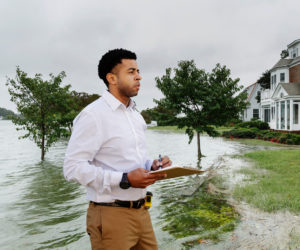In the first part of the series “The Mortgage Servicer’s Role in Navigating Insurance Claims,” we covered assessing property damage and applying insurance proceeds in compliance with the terms of the standard mortgage agreement. In part two, we discussed protecting the mortgagee’s rights under a homeowner property policy. In this final installment, we discuss maximizing coverage under a homeowner property policy.
Part III: Challenging the Denial
 Property damages losses attributable to Hurricane Harvey are expected to exceed $25 billion, but only a small portion of these losses will be covered by flood insurance through the National Flood Insurance Program. The standard homeowner policy excludes flood damage, but there are certain water damage losses that may be covered by a standard homeowner policy. Servicers should carefully evaluate property damage and policy language to maximize recovery under a standard homeowner policy.
Property damages losses attributable to Hurricane Harvey are expected to exceed $25 billion, but only a small portion of these losses will be covered by flood insurance through the National Flood Insurance Program. The standard homeowner policy excludes flood damage, but there are certain water damage losses that may be covered by a standard homeowner policy. Servicers should carefully evaluate property damage and policy language to maximize recovery under a standard homeowner policy.
Across most of the United States, a standard homeowner property policy will cover damage caused by windstorms, such as a tropical storm, hurricane, or tornado. Storms that create excessive winds can cause roof damage or cause trees and other debris to damage the exterior of property, including torn shingles or broken windows. This exterior damage can allow water to enter the property and cause further damage. Rain entering a home as a result of wind damage is not the same as flood damage, and such wind-related water damage should be covered by a standard homeowner policy.
The question that servicers will encounter in Harvey and other storm-related claims is what happens when property is damaged by both rain and flooding. Specifically, what water damage was caused by flood and what water damage was caused by wind-related rain? Insurance coverage in light of these competing causes is complicated by the anti-concurrent causation clause in most homeowner policies. Under this clause, a loss that is caused by a combination of covered causes and excluded causes will not be covered. In many jurisdictions, these clauses are enforceable. In other jurisdictions, however, such clauses are unenforceable by statute or in violation of public policy. Even in those jurisdictions that permit such clauses, if specific damage can be separated by causation, coverage may be available under a standard homeowner policy.
As noted in the second part of this series, a standard mortgage clause creates a separate insurance policy between the insurer and the mortgagee. In addition to the protections provided to the mortgagee previously discussed, the mortgagee provision should give servicers standing to make a property claim under the homeowner policy or to challenge the denial of such a claim. Servicers of loans secured by property that has sustained damage should take the following steps to maximize coverage or challenge the denial of a claim under a property policy:
- Describe the property damage carefully: When submitting an insurance claim or challenging a denial, describe property damage as “water damage” rather than damage cause by “flooding.”
- Identify evidence that could support a wind damage claim: Such evidence could include blown off shingles, downed trees, shattered windows, or breached doorways.
- Contact coverage counsel: Coverage counsel can help evaluate whether to file a claim or challenge the denial of a property claim based on the facts of the damage, the policy language, and the law of the jurisdiction.
Webinar – After the Waters Recede: The Mortgage Servicer’s Role in Navigating Insurance Claims
October 25, 2017
11:30 AM – 12:30 PM CST
Following the recent hurricanes that have damaged many homes beyond repair, borrowers may seek to apply any available insurance proceeds to satisfy the outstanding balance on their loans rather than repair the property. In this webinar, we will discuss precautions servicers should take to ensure they comply with the terms of mortgage agreements and applicable law to protect against potential liability.